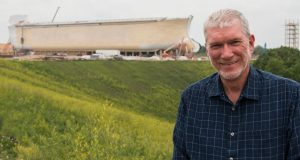While dinosaurs lie in the distant past, a couple of recent books The Rise and Fall of the Dinosaurs and Too Big to Walk, for those readers whose childhood fascination with dinosaurs extends into adulthood, are notable for showing that palaeontology is often entangled with personal quests and with personalities. Nick Mattiske writes.
Dinosaur history is inextricable from the more recent human history of discovery.
In the 18th century the fossils that were unearthed created puzzlement. What animals did these giant bones come from? When did they live? What did they mean for an understanding of Genesis and the Biblical Flood? It became clear that the animal kingdom was far richer than even what we see around us now.
In the 1970s and 80s, a major time for dinosaur discovery and prominence in the public imagination, dinosaurs, though intriguing, were still thought of as sluggish, dim-witted, lizard-like creatures that dragged their tails around and waded in swamps. And their disappearance remained a mystery. I remember a dinosaur book from my childhood ending with the words “nobody knows why”.
Now we do know why they died out, or at least we think we do (theories continue to change and be finessed). An asteroid that hit the Mexican Yucatan Peninsula along with volcanic activity in India that split the Earth and poured out vast quantities of lava and toxic gases are thought to have ended the dinosaurs’ long reign.
Their lives have been revisited also. A lack of marks relating to tail dragging amongst footprints indicates dinosaurs held their tails aloft for balance and were more fleet-footed, which resulted, amongst other things, in the realignment of displayed dinosaur skeletons in museums.
Birds, close relatives of dinosaurs, are smart, and most dinosaurs were thought to have been too, though the poor old stegosaurs continue to be labelled as dunces. The link to birds has been further strengthened by the discovery of traces of feathers in many dinosaurs, particularly in fossils from China, where an upsurge of fossil digs accompanies the rising economy.
Feathers do not automatically indicate flight, but were used for warmth and display, and palaeontologists are even beginning to picture what colours they might have been, due to the discovery of fossilised melanosomes, bearers of pigments whose various shapes correspond to various colours. Picturing dinosaur colour is something previously thought impossible.
Steve Brusatte is a palaeontologist with a particular interest in bird-like dinosaurs. His book is a brief history of the Mesozoic, the dinosaur era, neatly summarised by the title, The Rise and Fall of the Dinosaurs, and it relays the above developments in our understanding of dinosaur lives. But the book is as much about larger-than-life human figures, such as Edward Cope and Othniel Marsh, who fought the infamous 19th century “bone wars” and who were not above sabotaging each other’s work, and Barnum Brown, who is famous for unearthing Tyrannosaurus rex. Also included are Brusatte’s contemporaries, including Paul Sereno, who worked on the same sites as Brown and who was once named in People magazine’s list of “most beautiful”.
Palaeontology continues to be populated by enthusiasts and eccentrics, who continue to dig up the bones of new species and fight over orthodoxies and heresies. If Brusatte represents the current orthodoxy, Brian Ford gives us the heresies in Too Big to Walk. Ford is a microbiologist who has provoked velociraptor-like ferocity from many palaeontologists for speculating that large dinosaurs at least were semi-aquatic.
Ford’s book is really two books in one. The first half is an entertaining history of the disciplines of geology and palaeontology. Whereas Brusatte orders his book by the chronology of the Mesozoic, Ford takes us through recent centuries, along the way digging up odd facts and burying popular fallacies. But he does this to set up his own place in the history of palaeontological theorising. His main purpose is to outline in the second half of the book his theory (and its reception) that dinosaurs were just too large to live on land, but like hippos and crocodiles spent most of their time in shallow lakes or seas.
The theory is an ingenious answer to a number of questions. Water could buoy up the giant necks and tails of sauropods. Predators such as Tyrannosaurus rex could move more freely, using their tails as rudders, whereas on land turning sideways quickly would be problematic. Life in water would stabilise body temperature, doing away with the need for dinosaurs to be warm-blooded. Ford also argues that the dates of the Yucatan asteroid and the dinosaurs’ decline don’t match, and that the loss of habitat, shallow lakes and seas, due to the breakup of the supercontinent Pangea, better explains the dinosaurs’ extinction.
He has been ridiculed for these outlandish ideas, often simply because he is not a palaeontologist. Like the climate change denying minority, he is accused of selective reading—ironically, as Ford is not one of them and admires pioneering climate change scientists.
For his part, Ford gets into the thick of online name-calling, and his sometimes unwieldy book unnecessarily contains correspondence with editors and detractors, as well as repeated sections of text and untailored papers, giving the impression of indiscriminate defensive firing. He dismisses opponent’s arguments on the basis of spelling mistakes, which would invalidate his own book. He compares himself to Galileo and thinks everyone is vindictive except himself.
As far as his theory goes, those detractors that bother to be respectful pile up contrary evidence. Perhaps there is middle ground. Perhaps some dinosaurs were more aquatic than others. What is more certain is that dinosaurs continue to stir passion in more than just five-year-olds. Ford’s theory is something of a response, indicated by his book’s title, to the fact that dinosaurs were somewhat unbelievable. Their intriguing other-worldly nature continues to inspire the search for new understanding through new evidence and new ideas.
Nick Mattiske
Nick Mattiske is a bookseller and blogs at Coburg Review of Books.
The Rise and Fall of the Dinosaurs
Author: Steve Brusatte
Publisher: Macmillan
2018
To purchase visit Pan Macmillan Australia
Too Big to Walk
Author: Brian J. Ford
Publisher: 4th Estate
2018
To purchase visit Harper Collins
 JourneyOnline
JourneyOnline


